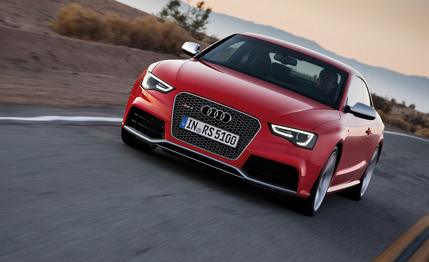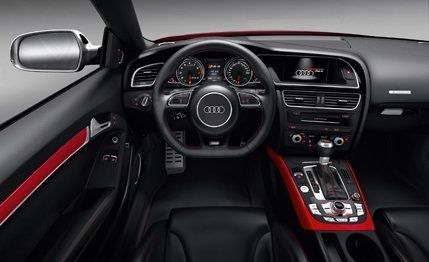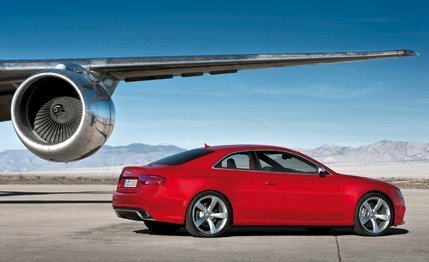
 First Drive Review
First Drive Review
We have waited patiently for two years to see the Audi RS5 on our shores. In 2010, we drove the RS5 in Germany, where we pitted it against the Cadillac CTS-V and BMW M3 on the autobahn and at the Nürburgring; unfortunately for Audi, its car finished last. But among that group, where the least powerful member packed 414 hp, there weren’t any losers, just different vehicles colored by varying shades of greatness.
Since it’s been a while, here’s a quick recap of the Audi’s bona fides: Built on the bones of the A5/S5 coupe, the RS5 is the result of a full working over by Quattro GmbH, Audi’s equivalent to BMW’s M division or Mercedes-Benz’s AMG outfit. It’s an in-house engineering skunkworks and is responsible for the R8, the TT RS, the RS4 Avant, and the RS6. Compared with “S”-badged Audis such as the S4, S6, and S8, RS models are more powerful, rarer, and more track ready.
Mellow Bellow
The 24-month hiatus having dulled our aural recall, the RS5’s thunderous exhaust note came across as a pleasant surprise. Our test car was equipped with the $1000 sport exhaust and had a mellow, warm waffling at idle, a riff that increased in volume and fever once we sent the 4.2-liter naturally aspirated V-8 toward its 8500-rpm cutoff. Flaps in the exhaust are closed at lower rpm but open as revs rise to decrease back pressure and pump up the volume. The R8’s V-8 wishes it sounded this mean.


Perhaps more accurately, the R8’s V-8 might wish it were this V-8. Stephan Reil, the head of development at Quattro, is quick to correct us when we wrongly assume that the RS5’s engine is the same as the one installed in Audi’s supercar. “The R8’s V-8 is of a slightly older generation. The RS5’s V-8 shares little or nothing with [that] engine. It is more powerful than the R8’s V-8 by virtue of the lessons learned from the 5.2-liter V-10.”
The RS5’s engine makes 20 more hp, for a total of 450. In that 2010 comparison test, the Euro-spec RS5 managed a 0-to-60-mph time of 4.0 seconds and a quarter-mile time of 12.5 seconds at a speed of 112 mph. Like the European model, the U.S.-spec RS5 will have an aggressive launch-control function that revs the engine to about 5000 rpm and then dumps the clutch. We’ll be testing the RS5 soon, and we expect it to roughly equal our previously published numbers.
Aluminum Sculpture
A peek under the hood reveals an engine that wouldn’t look out of place in a Ferrari. Red cam covers and a carbon-fiber-encrusted intake manifold are pure eye candy, but this V-8 is no poseur; it displays the same willingness to spin and quick throttle response as do the engines from Maranello. Having bucked the forced-induction trend, this naturally aspirated V-8 is graced with linear power delivery, with no peaks or hiccups, and it surges steadily until the limiter cuts in. It’s a race-worthy engine, but unlike the Cadillac CTS-V, BMW M3, and Mercedes-Benz C63 AMG, the RS5 is efficient enough to avoid a gas-guzzler penalty. The EPA fuel-economy numbers are expected to come in at 16 mpg in the city and 23 mpg on the highway.


Unlike the stellar TT RS, which is available in the U.S. solely with a six-speed manual, the RS5’s only gearbox is a seven-speed dual-clutch automatic. You won’t hear us condemn this transmission, but we are the Save the Manuals! gang, after all, and would be willing to sacrifice 10ths of a second in acceleration and lap times to be able to work more closely with this sweetheart of an engine.
For its part, Audi seems to be very concerned with those precious 10ths, as it has reportedly sped up the dual-clutch’s shift times for 2013 by reworking the transmission’s hydraulics. Shifts are banged off quickly, but the last RS5 we drove banged off shifts, too, and whatever improvement exists is too small for us to notice without having instrumented test numbers to back it up. Downshifts arrive quickly—so quickly, in fact, that the transmission occasionally slams into a lower gear. When creeping to a stop, there’s an occasional buck as the transmission selects lower gears.